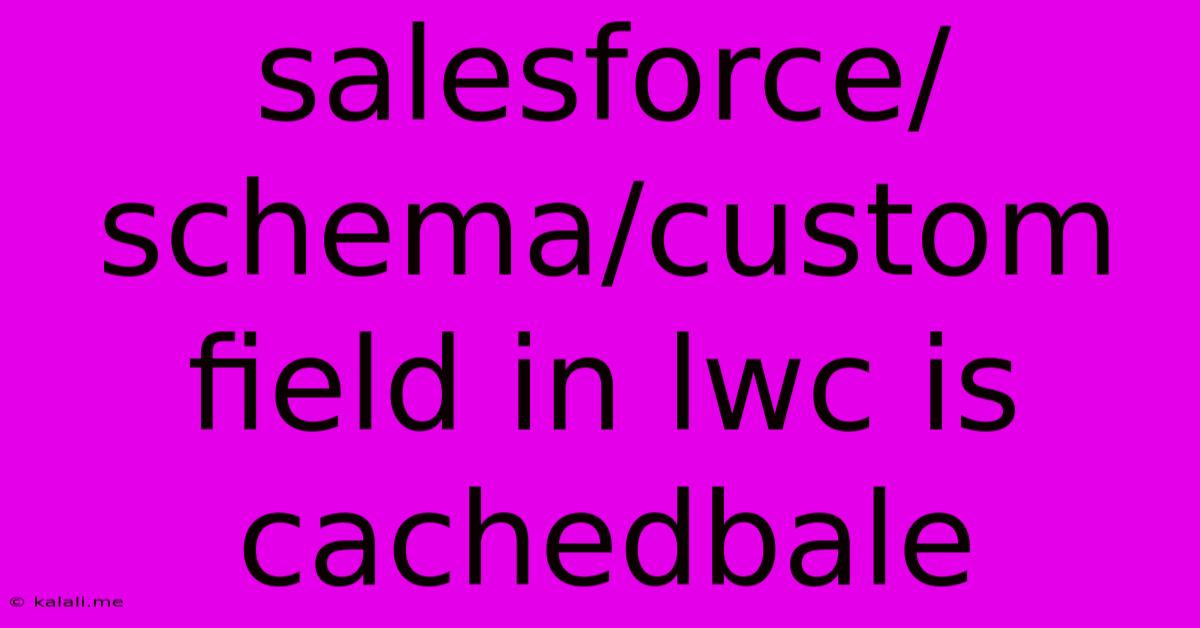Salesforce/schema/custom Field In Lwc Is Cachedbale
Kalali
May 25, 2025 · 3 min read

Table of Contents
Are Salesforce Custom Fields in LWC Cacheable? Understanding Data Handling and Performance
This article explores the caching behavior of Salesforce custom fields within Lightning Web Components (LWC). Understanding how data is handled and cached is crucial for building performant and efficient LWC applications. We'll examine different scenarios and best practices to optimize your data fetching strategies.
Understanding LWC Data Handling
LWC leverages the powerful capabilities of the Salesforce platform, but it's essential to understand how data is fetched and managed within the component lifecycle. While Salesforce itself employs various caching mechanisms at the server-side, the question of whether your custom fields are directly cacheable within the LWC itself is nuanced. There's no single "yes" or "no" answer; it depends on your data fetching approach.
Factors Affecting Caching:
-
@wireDecorator: When using the@wiredecorator to fetch data using Apex methods or SOQL queries, the framework does implement caching mechanisms to optimize performance. However, the caching strategy is managed by the framework, and isn't directly controlled by the developer at the custom field level. The cache invalidation depends on factors like record changes and data modification. -
Data Types and Field Usage: The nature of the custom field (text, number, lookup, etc.) doesn't directly influence whether the field is cached by the
@wiredecorator. The caching applies to the entire record retrieved, not individual fields. -
Apex Methods and SOQL Queries: The efficiency of your Apex methods and SOQL queries significantly impacts performance. Well-optimized queries that retrieve only necessary data minimize the cache footprint and improve responsiveness. Avoid
SELECT *statements whenever possible. Instead, explicitly list the required custom fields. -
@trackDecorator and Reactive Properties: While@trackmakes properties reactive, it doesn't inherently introduce caching. Changes to@trackproperties trigger component re-renders, but the underlying data retrieval still relies on the@wiredecorator's caching mechanism (or lack thereof if you're manually handling data). -
Manual Data Fetching: If you bypass the
@wiredecorator and fetch data using imperative methods (e.g., usinggetRecordor making direct calls to Apex), caching is largely your responsibility. You'll have to implement your own caching strategy using browser storage (localStorage, sessionStorage) or a custom caching mechanism.
Best Practices for Optimizing Data Fetching:
-
Minimize Data Retrieval: Only fetch the specific custom fields you absolutely need. Avoid retrieving unnecessary data to reduce the cache size and improve performance.
-
Use
@wireEffectively: Leverage the@wiredecorator to benefit from Salesforce's built-in caching. Optimize your Apex controllers and SOQL queries for efficiency. -
Consider Data Versioning: For scenarios where data changes frequently, explore ways to manage data versions effectively, possibly triggering re-fetches when necessary. Implementing this involves strategic use of record change events or timestamp comparisons.
-
Implement a Custom Caching Strategy (If Necessary): For more granular control or in cases where
@wireis insufficient, develop a custom caching strategy using browser storage. Ensure proper cache invalidation mechanisms are in place to prevent stale data.
Conclusion:
While Salesforce's LWC framework provides built-in caching through the @wire decorator, it's not a direct cache of individual custom fields. Instead, the caching operates on the entire data set retrieved. Optimal performance relies on well-structured data fetching (using targeted SOQL queries), efficient Apex controllers, and judicious use of the @wire decorator. For complex scenarios or situations requiring fine-grained control, a custom caching mechanism might be necessary, but this adds complexity. Remember to always prioritize efficient data retrieval and minimize unnecessary data fetching for a responsive and performant LWC application.
Latest Posts
Latest Posts
-
How Many Tablespoons Are In A Hidden Valley Ranch Packet
Jul 10, 2025
-
Which Is The Best Summary Of The Passage
Jul 10, 2025
-
How Many Quarts Of Soil In A Cubic Foot
Jul 10, 2025
-
What Is 3 4 Of A Pound
Jul 10, 2025
-
How To Measure 1 8 Teaspoon With 1 4 Teaspoon
Jul 10, 2025
Related Post
Thank you for visiting our website which covers about Salesforce/schema/custom Field In Lwc Is Cachedbale . We hope the information provided has been useful to you. Feel free to contact us if you have any questions or need further assistance. See you next time and don't miss to bookmark.